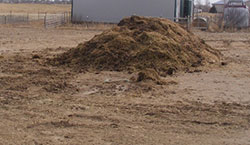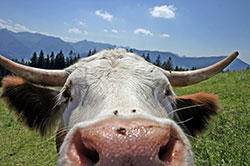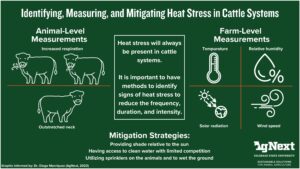Manure Mgmt
Manure Management Guidelines for Small Acreages – educational brochure explains why manage manure properly, best management practices and disposal options for small acreages in Colorado
Healthy Manure Storage Tips

- Divert clean water away from manure:
- Construct berms, terraces or waterways, and/or use downspouts to divert clean water away from corrals and manure storage areas.
- Ensure manure discharge will not enter a water body or leave the property:
- Limit animal access to ponds, streams, ditches, and wetlands.
- Collect manure frequently.
- Stockpile manure at least 100 feet outside a floodplain.
- Do not stockpile manure in a dry creek bed or ditch.
- Protect ground water:
- Locate manure storage piles and livestock corrals at least 150 feet down-gradient from wells.
- Use a 150 foot buffer around wells when land applying manure.
- Reduce nuisances like flies and odor:
- Stockpile manure downwind from barns and 200 feet away from neighbors.
- Plant trees to reduce wind and odor from stockpiles.
- Keep a lid on manure dumpsters.
- Remove manure from corrals and pens every few days to prevent flies, parasites, and worms.
- Cover fresh manure in stockpiles with at least 5 inches of clean bedding, straw, or hay to prevent flies.
- Prevent flies by using pesticides or fly predatory wasps (non-stinging) which can be purchased to manage flies.
Manure Disposal Options
- Dispose off-site to a landfill that accepts manure or hire someone to pick-up and dispose of manure for you.
- Compost manure. This requires the right ratio of carbon (bedding or leaves) and nitrogen (manure). Try 30 carbon to 1 nitrogen by volume. Water to keep the pile 50% moist and aerate the pile regularly.
- Spread manure. Spread in spring or summer. Test manure for nutrient content and spread based on soil test recommendations. This will ensure the nutrients are being utilized by the vegetation growing. Unused nutrients can pollute water bodies and groundwater. Callibrating your manure spreader is a great way to ensure you are using the right application rates, for more information about how to calibrate manure application click here. Remember that raw, fresh manure may contain weed seeds which will be spread back on the land.
- Using manure in gardens? Read Preventing E. coli From Garden to Plate
- Interested in learning more about manure composting? Read this article from NRCS.
- Watch this short video about dry manure spreader calibration. UW Extension Calibrating a Manure Spreader.
Estimated Horse Manure Application Rates*
- Dryland range: 1 ton/ac/yr
- Irrigated alfalfa: 5-10 tons/ac/yr
*Test manure for nutrient content and spread based on soil test.
Livestock Mgmt
Beef cattle
 Managing beef cattle can be a great way to utilize a small acreage if done correctly. There are different management systems that can be planned around the available resources on farm and the time and financial commitment to sustain a herd. For small acreage owners who work full-time off the farm, raising beef or leasing land for cattle grazing can be a great way to utilize their pastures.
Managing beef cattle can be a great way to utilize a small acreage if done correctly. There are different management systems that can be planned around the available resources on farm and the time and financial commitment to sustain a herd. For small acreage owners who work full-time off the farm, raising beef or leasing land for cattle grazing can be a great way to utilize their pastures.
How many animals can I graze?
Maintaining healthy pastures is crucial to sustain cattle over time. Determining carrying capacity, implementing rotational grazing, using indicator grasses to monitor when to start and stop grazing and keeping grazing records will help improve pasture health, allowing for more years of grazing for your animals. The amount of animals you can graze in an acre will depend on many factors, including forage production, type of grass, forage consumption and much more. In general, you want to be able to balance an animal’s forage needs with the forage available in your land, plus what you can supplement in the form of hay or feed. The table below shows the estimated forage needs of different animal classes. Remember ruminants consume an average of 2.6% their body weight daily forage.
|
Table 1 |
|||||||
|
Animal Class |
Pounds of Dry Forage* | ||||||
|
Consumed Per |
|||||||
|
Day |
Month |
Year |
|||||
| Cow with calf: |
26 |
790 |
9,490 |
||||
| 1 yr. Old Cattle: |
15.6 |
474 |
5,694 |
||||
| Mature Horse: |
32.5 |
988 |
11,862 |
||||
| Mature Sheep: |
5.2 |
158 |
1,898 |
||||
| Mature Goat: |
3.9 |
118 |
1,423 |
||||
Visit the Pasture and Range management section of this website to learn more about how to determine carrying capacity.
If you are new to managing beef cattle or want to learn more before you jump into raising cattle, here are a few considerations to keep in mind:
Housing and infraestructure: Beef cattle do not need much shelter, although weaned calves and cows calving will need at least an open shed during the winter months. Depending on the type of operation you run you may also need chutes for worming, dehorning, palpitating or vaccinating. Feed throughs may also be needed if you are supplemental feeding with concentrates.
Fencing is a must with beef cattle on small acreages. A few different options exist depending on the management you decide to do. In general a perimeter fence will be required and internal electric fences may help you manage grazing better.
Heat stress: It is impossible to get rid of heat stress on beef cattle systems, however the impact that it has on cattle can be reduced and mitigated. Providing shade, access to clean water with limited competition at all times and utilizing sprinklers on the animals and to wet the ground are just a few ways in which you can reduce heat stress on animals. Temperatures above 85 degrees and higher moisture content pose a high risk for beef cattle.
- Heat-stressed cattle may show signs like heavy breathing and panting, stretching their necks, remaining standing up longer than usual as they try to get more air flow around their body, and they may stop grazing. Beef cattle also tend to group together during heat stress, which aggravates the issue as they absorb other animals body heat. Planting a few trees around the property can help ease the effects of heat stress for cattle.
- Hauling cattle also increases the risk of heat stress, when possible, move cattle early in the morning or late at night to avoid heat related issues. You can watch this short 3-minute video to learn more about heat stress in beef cattle.
Selection: Whether you choose purebreed or crossbred calves, make sure to get the healthiest animals possible. Choices should be made based on an excellent combination of muscle, style, balance, alertness and desirable breed characteristics. Deciding the type of operation is also important when selecting animals. Replacement heifers, feeder cattle, small cow hers and feedlot production all have their particularities in terms of best breeds and requirements.
Reproduction and replacement: When raising a small herd on small acreages, artificial insemination may the most economically feasible way to breed your cows instead of keeping a bull. A stocker operation may be a good option if you are new to beef cattle. This allows you to learn from the beef market, behaviour and needs before you start worrying about a breeding program.
Nutrition: Adequate levels of protein, energy, water, minerals and vitamins are essential to achieve good production and keep your animals healthy. Grazing animals may obtain most nutrients from forages. Year-round grazing implies that animals will be left on pasture all year as their only source of food. Dryland small acreages may not always be able to supply forage year-round in Colorado, especially on drought years. Supplementing with hay or a balanced concentrate and roughaghe is also an option to consider, especially on drylands.
Lastly, you want to make sure that your beef cattle is not just a money pit or a very expensive hobby. You can plan ahead an make smart decisions to avoid big economic losses that have a big impact on your family budget. CSU Agriculture and Buisness Management has some useful decision tools you can review for determining things like optimal cow size, matching cow size to available forage, buying hay or selling cows and much more! Click here to see all of these and more resources.
Learn more about livestock production by listenting to Pasture for Profit Podcast. CSU Extension livestock specialists have prepared these short 15-20 minute discussion about different aspects of livestock producion that you can listen to to stay updated on the most current information.
Equine Biosecurity
Biosecurity is often thought of as a problem only for large operations, but there are small practices all horses owners can adopt to keep their animals healthy.
CSU has a set of Animal biosecurity resources to assist animal owners and farm managers to prevent infenctious disease among animals housed together or animals that are constantly moving from one place to another. Shipping or moving horses can weaken their immune system quickly, thus making them more susceptible to infectious dieseases. If you are moving horses to a different property or have horses coming to your property, make sure there is a safe and clean quarantine area located 35-200 meters away from other horses where your horse can remain for the first few days.
Download the Biosecurity Checklist for Barn Managers to keep track of all the measures to keep a safe horse barn.
If you are taking taking horses to shows and fairs keep these useful tips in mind:
- Use your own trailer for transportation. Don’t ship your horses with animals from other farms or ranches.
- Ship only in a clean and disinfected trailer.
- Avoid direct contact between horses, especially nose to nose.
- Bring your own equipment (e.g., water, feed buckets, brushes, sponges, etc.) and avoid borrowing it.
- Wash your hands often, especially when interacting with horses other than your own.
- Disinfect boots, equipment and grooming supplies before leaving the show grounds.
- When you get home, shower, put on clean clothes and shoes before interacting with other horses.
- Make sure all horses are up to date on vaccines, even if only one of your horses is leaving the farm for shows.
- Quarantine horses that have been off the farm for at least 2 weeks when possible.
Other horse owner resources:
- American Association of Equine Practitioners
- Tips to keep horses healthy during weekend events
- Equine Disease Communication Center
- Horse Protection Act
Livestock Management in the Mountains
Booklet developed specifically for Colorado mountain communities. Topics include fencing laws, dealing with predators, cold temperatures and snow, handling emergencies, poisonous plants, and much more.
Poultry

Backyard Poultry
Raising backyard chickens can provide you with fresh eggs, pest control, and hours of entertainment. Before you get started, here are a few considerations to keeping a healthy and happy chicken flock:
- Hens are productive egg layers for 2-4 years and have a life expectancy of up to 7 years. Egg production decreases as they age. Also, expect less eggs during the winter months.
- If you have a chicken coop or run area, aim for 10 square feet per chicken, and make sure they have access to soil or sand.
- Do not place nesting boxes directly below roosting areas. Chickens poop a lot at night, designating a different space for roosting will ensure your eggs are kept cleaner.
- What to do with the waste? Read this article from UGA about backyard poultry manure composting.
Backyard ducks
Ducks are relatively quiet birds, and often lay eggs more regularly than chickens do, and are less likely to bo broody. Ducks can also tolerate heat better than chickens, especially if given a source of water like a pond to cool off.
Before purchasing, do your research on breeds and select one that is appropriate for your goals. There is a wide variety of ducks for different purposes, from the egg laying ducks, to meat ducks, hybrids and show or ornamental ducks with more colourful feathers.
Visit this webiste to learn more about housing requirements for ducks.
Keeping multiple bird species
It is not uncommon to keep chickens, turkeys, guineas, geese and ducks together, however they do have different needs and behaviors, so keep this in mind, especially when planning the shelter for each type of bird. Another consideration for backyard poultry is to keep animals numbers to a manageable amount. Most bird flocks need a higher female to male ratio. In any scenario, keep in mind that domestic birds are preys and need adequate shelter from predators. Make sure you provide a safe and dry shelter for all your birds.
Learn more about poultry by clicking on the links below:
- Backyard Chickens overview article
- Ailments of Chickens Fact Sheet 2.505
- Keeping Layers for the Family Egg Supply
- Practical Feeding Methods for Small Poultry Flocks
- Home-Produced Chicken Eggs fact sheet
- Custom Meat Processing, Colorado Department of Ag
- Blueprints for Poultry Equipment and Housing Plans
- Poultry Emergency Disease Plan
- Small Scale Poultry – UMN Extension
- Small and Backyard Poultry – eXtension
- Brooding and Rearing Ducklings and Goslings – MU Extension
Sheep and Goats
Sheep and Goats
Goats are very popular animals for small acreages due to their small size, ability to browse, a relatively cheap diet and their fun, friendly nature. Goats can provide with meat, fiber, milk or other services like targeted grazing, which can be incorporated into a weed management plan, but goats are also often kept as pets.
As with any other domestic animal, breeds have been developed to fulfill the production needs of farmers. Dairy goat breeds are often the most popular. Some of them include the Nigerian Dwarf, Pygmy goats and Nubians. The Boer is a common meat goat, larger in size that can adapt well to rough terrains, while other more exotic goat breeds like teh faining goats are often kept as pets. Lately, the interest in targeted grazing has increased as well,so choosing goats that have a combination of good temperament, browsing skills and adaptability to different climates and terrains is crucial. Some of the most commonly used goat breeds for targeted grazing include the Alpine, Boer, Pygmy, Kiko and Spanish.

- Healthy Living with Goats: An overview of health issues for the backyard farmer.
- Raising Sheep & Goats for Profit – 20 min. video. Goat and sheep owners discuss manure and pasture practices, fencing, feed and water, predator control, housing, and treating sick animals.
Shelter needs for goats
Goats don’t usually need very elaborate shelter set ups. A simple three-sided shed, facing away from winds usually provides enough protection from the elements. In general, you need to provide goats with a dry area , or add bedding to keep the area dry, access to feed and water, and enought ventilation in the summer months.
Fencing is a must to keep goats in their designated area and safe from predators, although you can expect goats to escape even the most elaborate fences at some point. Guardian animals are a good idea to keep goats safe from predators. Llamas, alpacas, donkeys and some dogs make great guardians as they have natural insicts to protect their herd from wild animals.
How many goats can you keep in your land?
A mature goat needs approximately 3.9 pounds of dry forage per day, or 1,423 pounds of forage per year. Dryland native pastures on loamy soils produce around 375 pounds of usable forage per acre per year (that means, without overgrazing the pasture). That means you would need approximately 4 acres of native dryland pasture to feed one goat without suplementing hay. Forage production varies depending on soil types, irrigation and grass types.
If you are expecting to purchase most of the feed for your goats rather than grazing, you can have more flexibility on how many goats you can keep on a given area, since pastures do not constitute most of the animal’s diet. Overgrazing can have severe concecuences for your long-term goals, so if you are planning on grazing animals Click here to learn more about stocking rates and learn more about the capaciy of your fields to supply forage.
The rule of thumb for all grazing animals is to “take half, leave half” of the grass height to avoid overgrazing, which leads to bigger issues with noxious weeds and soil erosion.
Raising sheep
Just like goats, sheep are multi-purpose animals that can be raised for meat, milk, fiber, targeted grazing or as companions. When choosing a breed of sheep to raise you may encouter with meat producing, wool producing ot hair sheep, often used for meat production.
Fencing is a crucial part of planning any animal grazed on pastures. A good perimeter fence to keep livestock contained and protected from predators, along with subdivision fencing to allow for pasture rotation (especially in small acreages) will help ensure your sheep are safe and your pastures are productive for a long time.
Housing requirements depend on the time of the year. Old barns, sheds, and hoop houses can provide good shelter for sheep year round. The most important thing is to keep housing on elevated, well-drained sites protected from the wind and easy access to water and feed. Sheep can also be kept outside on pasture year round, although you may need to provide some stockpile hay grazing during the winter months. Adult sheep can withstand cold temperatures well but lambs will require shelter during the first few months of their lives, especially during cold months. Sheep will likely need shade or shelter during the summer months. Make sure you can provide some shaded areas either through sheds or access to trees, hutches or other structures to keep them cool during the hottest hours of the day.
Be mindful of the common diseases, parasites and viruses that can affect your flock. Newly acquired animals or show sheep should be quarantined after an event. Parasites are a big threat for sheep. Proper deworming practices are crucial to keep a sustainable herd.
Targeted grazing
Targeted grazing has gained popularity as a method to control some noxious and invasive weeds using animals like goats, sheep and sometimes cattle. Grazing for weed management is a long process that requires great understanding of the weed’s lifecycle and animal behaviour. Additionally, managers should also have good understanding of the desired vegetation. A good targeted grazing plan should supress invasive weeds and provide competitive advantage to desirable vegetation, while also providing good forage for the grazing animals. Weed control by grazing is not a quick fix, it may take years to achieve full control
Sheep, cattle and goats can target different weed species depending on their eating behaviors. Identifying poisonous weeds is also crucial to create an effective grazing plan. If you are interested in learning more about targeted grazing the University of Idaho has a thourough guide for targeted grazing, whether you are wanting to start your own operation or just get an understanding of how this process works before you contact a targeted grazing company. Click here to read the “Targeted Grazing: A natural approach to vegetation management Handbook”.
Animal Emergency Preparedness
- Caring for Livestock Before Disaster – CSU factsheet
- Caring for Livestock During Disaster- CSU factsheet
- Caring for Livestock After Disaster- CSU factsheet
- Community Disaster Animal Planning Toolkit and Saving pets, saving people – 15 min video that provides an overview of the community process of animal disaster planning
- General disaster info at EDEN
Rabies in Colorado
Rabies is regularly found in Colorado wildlife, even in urban areas. As of 7/24/2024, 27 animals have tested positive for rabies in the state (mostly in the Front Range). Stay up to date on rabies numbers by visiting Colorado Department of Public Health & Environment Website.
- Do not handle wildlife, especially skunks, raccoons, foxes and bats that are acting inappropriately or have died.
- Vaccinate your pets and livestock.
- Call your doctor immediatly if an animal bites you. Contact your local health department to report the incident or any potential contact with rabid animals.
Resources
Resources & Helpful Information
SAM Webinars and Web Videos
- Alpacas & Llamas: The Sustainable Livestock
- Animal Emergency Preparedness
- Backyard Chickens
- Considerations for Raising Chickens on your Property
- Equine Biosecurity: What can you do?
- Fundamentals of Small Acreage Swine Production
- Livestock Nutrition for Small Acreages
- Non-Structural Carbohydrates in Horses and the Role of Forages
- Planning for a Sustainable Homestead
Guide to Planning on Your Property - Poisonous Plants and Horses
- Poisonous Plants of Colorado
- Raising Sheep and Goats
- Small Scale Cattle Production – Things to Consider
- Temple Grandin – Handling Cattle and Other Livestock
SAM Newsletter Articles
- Picking the Right Chicks for You – spring 2020
- Bird Migration Timing – winter 2020
- Where do Bees go in Winter – winter 2020
- Salmonella Outbreaks Linked to Backyard Poultry – fall 2019
- Rabbit Ownership – summer 2019
- The Relationship of New Spring Grass to Gas And Colic and Nutritional Laminitis in the Horse – spring 2018
- Locoweed Effects on Horses and Livestock – spring 2018
- Tips for Managing Livestock in Winter – winter 2018
- Small Flock Poultry Processing – fall 2017
- Are My Hens Still Laying? – fall 2016
- Backyard Chicken Harvesting – spring 2016
- Is this the Year of Voles? – spring 2016
- Paddock Paradise Track System For Horses – summer 2015
- Rain and Hay Production – summer 2015
- Backyard Poultry Safety – spring 2015
- New Regulations for Small-Scale Producers of Chicken Eggs Focus on Food Safety – spring 2015
- Winter Water for Livestock & Horses
- Western Whorled Milkweed Poisoning in Livestock
- From 4-H Goat Project to Cheesemaking School – fall 2014
- Vesicular Stomatitis In Colorado – fall 2014
- Animal Welfare Approved Label – summer 2014
- Winter Livestock Care – winter 2014
- Healthy Living With Goats – fall 2013
- Hydroponic Fodder Production – spring 2013
- Goats – spring 2013
- Dexter Cattle – winter 2013
- Animal Disease Traceability Rule Released – winter 2013
- Drought Calls for Change in Grazing – winter 2013
- How to Assess Hay for Quality – fall 2012
- High Nitrates in Drought Stressed Forage – fall 2012
- Raising a Pig for Meat – winter 2011
- Brown or White? Let’s Talk Eggs – winter 2011
- Manure: A Renewable Resource – summer 2010
- Backyard Chickens – summer 2010
- Toxic Weeds and Horses – spring 2010
- Feeding Your Horse – spring 2010
- Animal Grazing Habits – winter 2010
- Animal Mortality Planning – summer 2009
CSU Extension Fact Sheets
- Nitrate Poisoning fact sheet
- ATTRA Livestock, beef, dairy, sheep, goats, hogs, and poultry info
- Livestock Factsheets
- National Ag Library: Best single source of research based information on everything Ag
- Poisonous Plants
- Rabies in Horses: Should Horses be Vaccinated in Colorado?
- Stretching Your Horse’s Hay Supply During Drought






